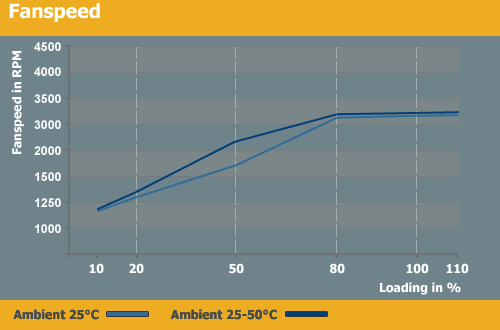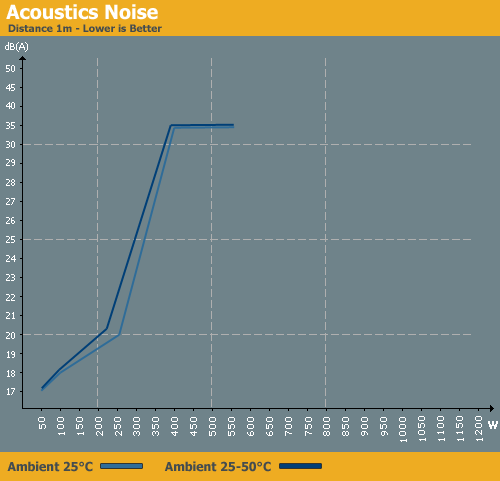PC Power & Cooling Silencer 500W
by Christoph Katzer on June 9, 2008 2:00 AM EST- Posted in
- Cases/Cooling/PSUs
Fan Speed

The fan starts rotating at 1240 RPM, which is already somewhat high. It would be perfectly acceptable to keep the fan at this speed until higher loads, since the power supply doesn't really get much warmer inside until higher loads. However, as the graphs show the fan starts turning faster with every single step of load we applied. The maximum 3200 RPM is reached quite fast at only 80% of load, which is clearly not necessary. PCP&C continues to ascribe to the "better safe than sorry" approach to PSU cooling - not a bad idea, but also not necessary at some point.
Acoustics

The acoustics table shows it clearly that there is a heavy increase in acoustic noise during operation. We could live with the 20dB(A) reached at a medium load of 250W, but 35dB(A) with just a little more than 350W more isn't something we would be happy with. To put things in perspective, we've tested other power supplies that deliver over 1000W of power without reaching such a high noise level. We're not at all convinced by the "Silencer" name in this case.










22 Comments
View All Comments
irev210 - Wednesday, June 11, 2008 - link
Is it just me or is this just an overpriced antec earthwatts 500W PSU?This is EXACTLY the same internals as earthwatts at a 50% price premium.
How depressing :(
C'DaleRider - Tuesday, June 10, 2008 - link
[QUOTE]OST are often used by Seasonic, but they don't have the best reputation.[/QUOTE]I'd amend that comment by adding "not uncommon for lower end Seasonic power supplies" to that because I defy you to find OSX caps in anything other than a lower-end Seasonic build....and in nothing that is placed as coming from a "premium power supply maker."
Anything other than a lower end build from Seasonic will have nothing less than RubyCon, Hitachi, and/or Chemi-Con caps in them....and to imply OSX caps are being used indiscriminately throughout all Seasonic's builds, which that single comment implies, is wholly incorrect.
Again, outside of basic bottom-feeder builds from Seasonic, such as an Antec Earthwatt, I defy you to find a single OSX cap anywhere in their builds.....Corsair certainly has none in any of theirs, Seasonic uses none in anything of 500W or greater capacity, and to find OSX caps in a PCP&C power supply, no matter the wattage, is to see the influence of OCZ finally rearing its ugly head in cost cutting. To save a couple of dollars in what it costs Seasonic to use OSX over Chemi-Con or Hitachi or the like is troubling, esp. given PCP&C's marketing position as a "premium" product.
yyrkoon - Tuesday, June 10, 2008 - link
I find it a bit silly that you ask to 'not soil' your name brand of choice, but then you go and soil about 5 other brand names yourself.Well done ! (not).
HOOfan 1 - Tuesday, June 10, 2008 - link
all of the brands he mentioned were made by Seasonic.The capacitor selection was also most likely the choice of PC P&C and Antec, not Seasonic.
Just like it was likely Antec's choice to use Fuhjyyu capacitors on the CWT built units.
What C'Dale Rider is objecting to is the author's assertion that it is somehow Seasonic's choice to use questionable capacitors, when it is more likely the choice of the company they make the unit for.
Corsairs are made by Seasonic and they use Hitachi and Nippon Chemicon capacitors..as do Seasonic's own branded PSUs.
Christoph Katzer - Wednesday, June 11, 2008 - link
Depends on the budget for the product. But don't think the buyer is going to search for components and probably even purchases them himself. The manufacturer chooses them according to budget and MAYBE presents a selection to choose from.The Irish Patient - Monday, June 9, 2008 - link
Christopher,Is there any particular reason that all of the PSU reviews at Anandtech limit efficiency ratings to outputs of about 50W and higher?
Like it or not, I rarely shut my computer off. A typical week is probably 10 hours running and 158 hours in standby. For all I know, my power consumption during standby may exceed consumption during actual usage, depending on how low the efficiency during standby is. However, the point is that I don't know since there's no data available.
Just making it up, assume that power supply output during standby is 2W but efficiency is only 10%. That would be about 14 kilowatt-hours consumed during a month.
Given the trend to "green" electronics, it wouldn't hurt to include this spec in your reviews.
mindless1 - Monday, June 9, 2008 - link
No, it is always true that standby uses less power. Even if efficiency goes down it is always inherant that it be using less total power FOR that efficiency to go down (it is the cause of efficiency going down).Therefore, you are basically worrying about nothing important. If power consumption itself is important then hibernate, don't go only into standby.
Christoph Katzer - Monday, June 9, 2008 - link
Hi, I had standby efficiency ratings in the beginning but nobody seemed to be interested in it. Standby efficiency is never really good but i can surely include then in future again. :)icingdeath88 - Monday, June 9, 2008 - link
SecondedAlso, I think it would be cool if you guys did an article (or blog, I'm not picky) about computers vs the electric bill. For example, how to calculate how much of an effect a given computer will have on electricity usage. Like, add up the power usage of graphics cards, CPUs, etc., in use and at idle, and factor in the time it's on/standing by/off.
I'm still in shock that for the month out of the year that my computer was out of commission (i broke it good). My electric bill was only about 1/2 - 2/3rds of what it normally is. That's a huge difference even though I live in a small condo. And you could bring it back around to the performance side of things by showing what a difference overclocking can make on power usage.
I know it's a depressing subject, but efficiency and envirenment-consciousness are important to a lot of people right now.
mindless1 - Monday, June 9, 2008 - link
That would hardly require a blog. Just a chart or even rough guess then look at your power bill for the KWH cost and the math is simple.Or look at the power bill to get cost and program that into a Kill-A-Watt meter.